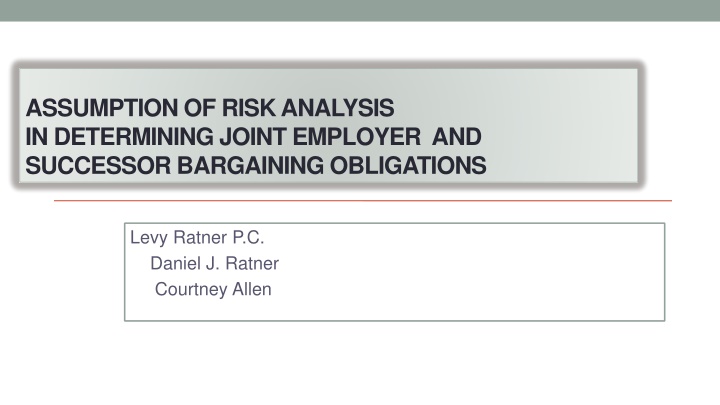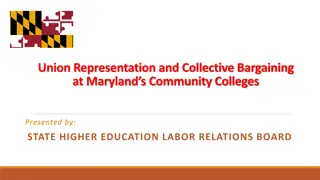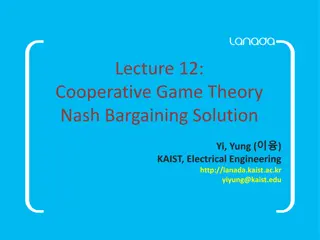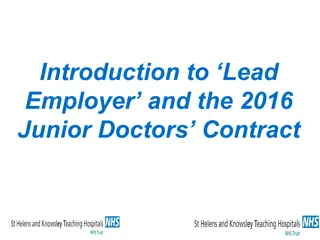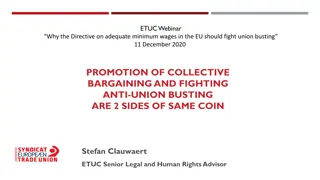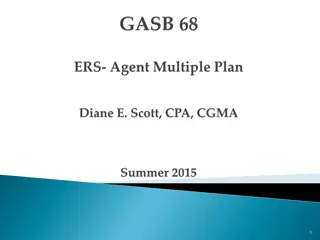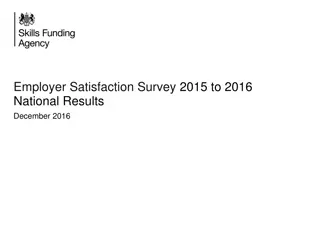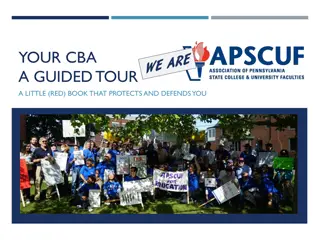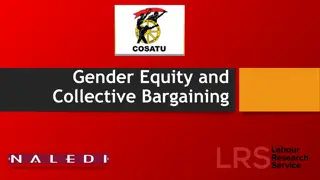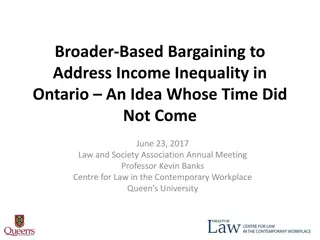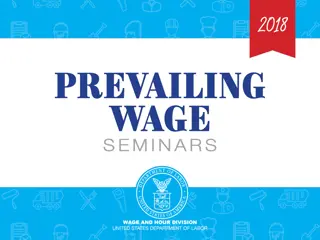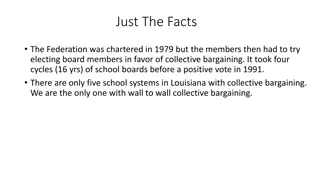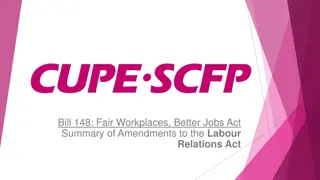Analysis of Joint Employer and Successor Bargaining Obligations
Delve into the complexities of joint employer relationships and successor bargaining obligations through the lens of assumption of risk analysis. Explore key cases, such as Browning Ferris Industries and Nexeo Solutions, to understand the evolving legal landscape surrounding collective bargaining rights and employee representation.
Download Presentation

Please find below an Image/Link to download the presentation.
The content on the website is provided AS IS for your information and personal use only. It may not be sold, licensed, or shared on other websites without obtaining consent from the author.If you encounter any issues during the download, it is possible that the publisher has removed the file from their server.
You are allowed to download the files provided on this website for personal or commercial use, subject to the condition that they are used lawfully. All files are the property of their respective owners.
The content on the website is provided AS IS for your information and personal use only. It may not be sold, licensed, or shared on other websites without obtaining consent from the author.
E N D
Presentation Transcript
ASSUMPTION OF RISK ANALYSIS IN DETERMINING JOINT EMPLOYER AND SUCCESSOR BARGAINING OBLIGATIONS Levy Ratner P.C. Daniel J. Ratner Courtney Allen
THE CHALLENGE AHEAD Wage Stagnation Wealth and Wage Inequality
THE CHALLENGE AHEAD The Act is one tool to address these issues: NLRA Section 1: Congress declared that the right of Employees to bargain collectively promotes the flow of commerce and the adjustment of wages The Supreme Court has emphasized: AHA v NLRB, 499 US 606 (1991) central purpose of the Act is to facilitate employees opportunity to organize and represent themselves in collective bargaining
Discussion: Assumption of Risk Analysis in Deciding Cases Involving Joint Employer and Successor Bargaining Obligations Reviewing the dissents in Board decisions in the areas of: Joint Employer Browning Ferris Industries, 362 NLRB No. 186 (2016) Miller & Anderson, 364 NLRB No. 39 (2016) Successorship Nexeo Solutions, 364 NLRB No.44 (2016 Creative Visions Resources, 364 No. 91 (2016)
JOINT EMPLOYER Flip Sides of the Joint Employer Question: Who is a Joint Employer? (Browning Ferris Industries) What is the Appropriate Unit of Joint Employees? (Miller & Anderson)
WHO IS A JOINT EMPLOYER? Browning Ferris Industries (BFI) Background Case Law: Early Board department store cases leading up to Boire v Greyhound, 376 US 473 (1964) found joint employer status where there was the authority to control terms and conditions whether direct or indirect In two 1984 cases, TLI, Inc., 271 NLRB 798 (1984) and Laerco Transportation, 269 NLRB 324 (1984), Board reversed and held that joint employer status required immediate and direct exercise of authority BFI reverses Laerco and TLI and now holds that the authority to control terms, whether or not exercised, is sufficient
WHO IS A JOINT EMPLOYER? Browning Ferris Industries (BFI) Majority relied on: Restatement (Second) of Agency Long Board history of finding joint employer status based on authority to affect terms rather than the actual exercise of authority or right to control Acceptance by circuit courts: Greyhound Corp., 153 NLRB 1488 (1965), enf d 368 F.2d 778 (5thCir. 1966)
WHO IS A JOINT EMPLOYER Browning Ferris Industries Dissent: While questioning the common law application, primarily focuses on the impact of the decision No bargaining table big enough to accommodate all parties Majority actually relies on an economic realities test Learco and TLI lead to certainty and predictability
Assumption of Risk Analysis Certainty and Predictability v. Confusion and Frustration Employers have voluntarily chosen the relationship they can work out the costs of the assumed risk between them: Dissent: focuses on what he maintains is a beneficial result from Laerco and TLI certainty and Predictability BUT Ivan Castelon, a direct beneficiary of the Act, finds that Laerco and TLI result in confusion and frustration How are we to interpret the two competing results of Laerco and TLI as it is likely that Joint Employer will come back before the Board
What is the Appropriate Unit of Joint Employees? Miller & Anderson Background Case Law: Lee Hospital, 300 NLRB 947 (1990), relying on Greenhoot, Inc., 205 NLRB 250 (1973), the Board held that a combined unit of single and joint employees would only be permitted with both employers consents. In MB Sturgis, 331 NLRB 1298 (2000), Board reverses Lee Hospital, and holds that consent is not required. Then in Oakwood Care Center, 343 NLRB 659 (2004), Board returns to the consent standard. Finally, in Miller & Anderson (2016) the Board goes back to the Sturgis standard where no consent is required.
What is the Appropriate Unit of Joint Employees? Miller & Anderson Majority: Meets community of interest test Statutory Appropriate Unit standard doesn t limit to one employer Facilitates pooling of economic interests and giving supplier employees a voice
What is the Appropriate Unit of Joint Employees? Miller & Anderson Dissent: Joining Unrelated Entities therefore need consent Uncertainty for user and supplier Difficulty in apportioning which employer responsible for which terms
Assumption of Risk Analysis User and Supplier know in advance what they are going to do, and are therefore in a better position to factor these costs into their financial agreement. Gallenkamp Stores v. NLRB, 402 F.2d 525 (9thCir. 1968) K-Mart and their licensees have worked out their diverse business problems to meet the need of the joint enterprise.
SUCCESSORSHIP Successor Law Raises the Same Assumption of Risk Criteria: Successorship is a time when workers, regardless of how long they have been represented face a high degree of uncertainty and vulnerability.
SUCCESSORSHIP Basic Law: NLRB v Burns Security Services, 406 US 272 (1972) Buyer (Successor) is ordinarily not bound by the terms of the CBA negotiated by the seller, and can set initial terms prior to bargaining (assuming the majority of employees are retained by the buyer). Perfectly Clear Exception: In Burns and later Sup Ct cases (e.g. Fall River Dyeing & Finishing Corp. v NLRB 482 US 27 (1987))Sup Ct carved out the perfectly clear exception which requires the buyer to first bargain with the incumbent union prior to unilaterally setting terms. In Spruce Up, 209 NLRB 1974 (1974), the Board applies perfectly clear exception when a buyer hires the majority of the seller s employees, operates the business in substantially unchanged form and the seller has actively or tacitly created circumstances where employees have been lead to believe that there would be no substantial change in terms of employment. Where employer clearly announces intent to change terms at outset then no perfectly clear successorship
SUCCESSORSHIP In Nexeo and Creative Vision the question before the Board was whether the buyers had failed to communicate their intent to set new terms with sufficient clarity and in sufficient time to avoid the perfectly clear exception.
SUCCESSORSHIP Nexeo: November Purchase Agreement provided that buyer would offer to hire the incumbent workforce on the closing date on substantially identical wages and other terms. The successor was to begin operations the following April. Communications to employees from November to April, which continued the Purchase Agreement commitment to hire on substantially similar terms, were made by seller s executive who was to be retained by the buyer. After hiring on April 1st, buyer informs workers of intent to unilaterally change terms.
SUCCESSORSHIP Creative Vision: Buyer to assume operation on June 1st. On Mar 20th, hiring process starts, no interviews or applications prior to hiring, only filling out new W4 tax forms. Employees start on June 2d with buyer, when employees are told for 1sttime that there would be new terms.
SUCCESSORSHIP Majority (Nexeo & Creative Vision): In both cases the employer failed to clearly announce its intent to change terms either prior to or simultaneously with its expression of intent to retain the predecessor s employees. In both cases employers waited too long, because the impression was that the buyer was assuming the existing terms with the seller.
SUCCESSORSHIP Dissent: Nexeo The statements in the Purchase Agreement were not a guarantee to the workers of continued terms The statements by the seller s executive (who was being retained by the buyer), were made at a time that he was employed by the seller and therefore could not be binding on the buyer no actual authority. Creative Vision Buyer s hiring process from May 20thto June 1stwas in a state of flux Giving workers new tax forms indicated an intent to change terms
Assumption of Risk Analysis Buyer and seller know their goals and can protect their interests in the sale agreement. Bright line test: Rather than parsing the facts to glean what employees should or should not have understood, to fall within the perfectly clear exception, the buyer must make it perfectly clear to incumbent employees in its first statements of its intent to hire. For the employees, the continuation of their terms should not be a legal exercise.
